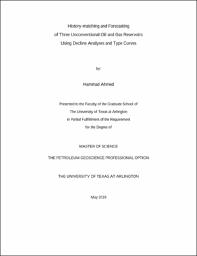
ATTENTION: The works hosted here are being migrated to a new repository that will consolidate resources, improve discoverability, and better show UTA's research impact on the global community. We will update authors as the migration progresses. Please see MavMatrix for more information.
Show simple item record
| dc.contributor.advisor | Hu, Qinhong | |
| dc.creator | Ahmed, Hammad | |
| dc.date.accessioned | 2019-05-28T16:01:18Z | |
| dc.date.available | 2019-05-28T16:01:18Z | |
| dc.date.created | 2019-05 | |
| dc.date.issued | 2019-05-10 | |
| dc.date.submitted | May 2019 | |
| dc.identifier.uri | http://hdl.handle.net/10106/28078 | |
| dc.description.abstract | Reservoir modeling of shale gas and tight oil presents numerous challenges due to complicated transport mechanisms and the existence of fracture networks. Even then, oil and gas companies have not slowed down on shale hydrocarbon investment and production using horizontal well drilling and hydraulic fracturing techniques. Many small oil companies may not have the budget to build a reservoir model which typically requires drilling test wells and performing well logging measurements. Even for large oil companies, building a reservoir model is not worthwhile for the evaluation of small-scale oil fields. Comprehensive numerical simulation methods are likely impractical in those cases. Decline Curve Analysis (DCA) is one of the most convenient and practical techniques in order to forecast the production of these reservoirs.
With the rapid increase in shale hydrocarbon production over the past 30 years, there have been numerous production data for shale gas reservoirs. Many different DCA models have been constructed to model the shale hydrocarbon production rate, from the classical Arps to the latest and more advanced models; each has its advantages and shortcomings. In practice and in all existing commercial DCA software, most of these DCA models are implemented and open to be used. Most of the deterministic DCA models are empirical and lack a physical background so that they cannot be used for history-matching of the reservoir properties.
In this study, popular DCA models for shale gas reservoirs are reviewed, including the types of reservoirs they fit. Their advantages and disadvantages have also been presented. This work will serve as a guideline for petroleum engineers to determine which DCA models should be applied to different shale hydrocarbon fields and production periods. The research objective also includes evaluating the performance of top unconventional plays (Bakken, Barnett, and Eagle Ford). Productions by counties are analyzed and compared to see how they stack up against each other. One section of this study also sheds some light on the future of shale gas and tight oil plays based on the simulation of models created. | |
| dc.format.mimetype | application/pdf | |
| dc.language.iso | en_US | |
| dc.subject | History-matching | |
| dc.subject | Forecasting | |
| dc.subject | Unconventional | |
| dc.subject | Decline analyse | |
| dc.subject | Type curves | |
| dc.title | History-matching and Forecasting of Three Unconventional Oil and Gas Reservoirs Using Decline Analyses and Type Curves | |
| dc.type | Thesis | |
| dc.degree.department | Earth and Environmental Sciences | |
| dc.degree.name | Master of Science in Earth and Environmental Science | |
| dc.date.updated | 2019-05-28T16:01:20Z | |
| thesis.degree.department | Earth and Environmental Sciences | |
| thesis.degree.grantor | The University of Texas at Arlington | |
| thesis.degree.level | Masters | |
| thesis.degree.name | Master of Science in Earth and Environmental Science | |
| dc.type.material | text | |
Files in this item
- Name:
- AHMED-THESIS-2019.pdf
- Size:
- 3.336Mb
- Format:
- PDF
This item appears in the following Collection(s)
Show simple item record


